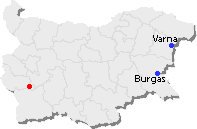
Presently the monastery is situated in southeastern part of Bulgaria, on the right bank of Rilska river, where the right tributary river Drushlyavitsa flows into it, about 17 km northeast from the town of Rila and very close to the village of Pastra. That is not far from the place where it was first established. Rila monastery is the biggest monastery in Bulgaria with 5 storeys, only 4 of which visible. That peculiarity of the building is explained by the limits being set by the Ottoman authorities in 1834 when the building was constructed. The base floor houses the museum. The place where the food for the monks was prepared is the Magernitsa. The establishment has a statute of a monastery village. Yet from the beginning of its founding the monastery becomes a center of culture and education. During the Renaissance period Neofit Rilsky established a primary cell school there.
During the second half of the X-th century many religious movements flourished on the Balkan Peninsula. The Bogomil movement appeared thus increasing both the influence of the heretic sectarianism and the number of
hermits on the Peninsula. These events have led to the foundation of several large monasteries, the most important of which is the Rila monastery, named after the hermit and priest St. Ivan of Rila.
The construction started in 946, just before St. Ivan of Rila’s death. It is presumed that the first monastery was situated east of the present day building and close to the hermit cave. During XIII – XIV C. construction of the monastery on the present site started .
Several frescoes from end of XVIII and beginning of XIX C. reveal the picture of the late middle-age Rila monastery. The frescoes depict a 2 and 3 storey monastery building wings with rooms, whose massive walls are supported by pilasters. The architectonics of the monastery is very similar to that of the Hrelyo tower.
The serious renovation works of the holy place began in 1816.
During the first stage of the construction (1816 - 1817) the master builder named Alexi from the village of Rila erected the north corner of the building - the one that surrounds the establishment. In the next 1818 and 1819 years the remaining part of the wing – starting from the kitchen (Magernitsa) and finishing to the south corner, was constructed. The two front gates of the monastery – the Samokov and Dupnitsa gate are included in that construction.
The rebuilding of the monastery complex during the Renaissance time was marked not only with those well noted buildings but also with the erection of a number of smaller ones. Between the end of XVII and the beginning of XIX C. outside the monastery Citadel were build: The Bone vault (1794 - 1795); The Scythian „St. Luka" (XVIII - XIX C); The Church , belonging to the so called “Old anchorite ” (1746 г, additionally built in 1820 ); The convent “Pchelino" (XVIII and XIX C); The new buildings in „Orlitsa" (XIX C); The convent in the town of Rila (XIX C); The Bekleme (XIX C); The Bakery near the Samokov gate (1866) etc.
The masterpieces and the scripts in the Rila monastery are dated back to X - XI C. The glagolhic papyrus from XI C. proves it. In the archives and the monastery library are kept many other valuable documents and manuscripts from XII - XVIII C.
Very important from historic point of view are: The Tzar Ivan Shishman diploma (1371-1393 г.) issued on September 21, 1378 , signed and stamped with the gold stamp of the Tzar , showing that he granted to the monastery the feudal power to rule over 20 villages including their land; Several Turkish fermans issued by the Sultan dated to XV and XVI C.; The script built in with bricks on the south wall of the middle-aged tower dated to 1335; The lyrical panegyric script on the burial stone of the local feudal owner /protosevast/ Hrelyo from 1342 C.; The Pact for co-operation signed by The Rila monastery and the Russian monastery “St.Pantaleymon” of mount Athon from 1466; The diplomas of the Russian Tzar Ivan the IV – the Ugly etc., while the frescoes in the Hrelyo tower are among the best quality works of Bulgarian art from the XIV C .
Nowadays the monastery ensemble comprises of a territory of 8800 sq. m., 5500 sq. m. of which are occupied by the monastery building. Its 4 and 5-storey wings, build up during different periods of time, surround from all sides the only yard of the monastery shaped like an irregular pentagon.















